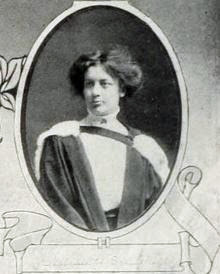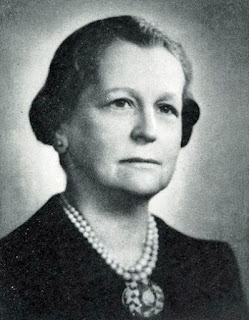For a quarter of century, from the mid-1930s to 1960, Elizabeth Dafoe was a central figure in the development of the University of Manitoba library in Winnipeg. No less important was her influence in Manitoba and at the national level. Her efforts were noteworthy and resulted in her selection to represent western Canadian and academic interests in the wartime Canadian Library Council which led to the successful formation of the Canadian Library Association in 1946. Dafoe’s pan-Canadian interests included the formation of regional libraries, a topic she promoted in wartime publications, and the creation of a National Library in Ottawa. She was President of the Canadian Library Association in 1948-49. From 1953-1960, she was a member of the National Library Advisory Council. The University of Manitoba Library was named in her honour in 1961.
Julia Annette Elizabeth Dafoe
Born Oct. 22, 1900, Montreal, QC; Died 25 April, 1960, Winnipeg, MB
Education:
BA 1923 (University of Manitoba)
LS diploma (New York Public Library School) 1925
1938-39 summer courses at University of Chicago Graduate Library School
Positions:
1925-26 Circulation and Reference Assistant, University of Manitoba
1926-27 Cataloguer, University of Manitoba
1928-1932 Assistant Circulation and Reference Librarian, University of Manitoba Library
1932-35 Chief Cataloguer, University of Manitoba Library
1935-1937 Chief Librarian, Junior Division, University of Manitoba Library
1937-1960 Chief Librarian, University of Manitoba Library
Publications:
Dafoe, Elizabeth (1944). “A National Library.” Food for Thought 4, no. 8: 4–8.
Dafoe, Elizabeth (1945). “Regional Library Service.” Queen’s Quarterly 52, no. 2: 195–205.
Dafoe, Elizabeth (1946). “Your Next Job–Librarian [C.B.C. Broadcast., September 4th, 1945].” Canadian Library Council Bulletin 2, no. 5: 106–7.
Dafoe, Elizabeth (1947). “The First Year: The Canadian Library Association Reports.” Food for Thought 8, no. 2: 9–10, 27.
Dafoe, Elizabeth (1948). “Librarianship as a Career.” Ontario Library Review 32, no. 3: 199–200.
Dafoe, Elizabeth, Freda F. Waldon, and Colin Gibson (1948). “A National Library for Canada.” Canadian Library Association Bulletin 5, no. 1: 14–16.
Dafoe, Elizabeth (1948). “What Is a Librarian?” Ontario Library Review 32, no. 1: 19–22.
Dafoe, Elizabeth, Freda F. Waldon, and Colin Gibson. “A National Library for Canada.” Canadian Library Association Bulletin 5, no. 1 (July 1948): 14–16.
Dafoe, Elizabeth (1949). “National Library Service.” Canadian Library Association Bulletin 6, no. 2: 54–57.
Dafoe, Elizabeth, ed. (1955). Future of bibliography and documentation. By Elizabeth Dafoe and others. Ottawa: Canadian Library Association. (Canadian Library Association. Occasional paper; no. 7)
Dafoe, Elizabeth (1955). “Research Libraries.” Canadian Library Association Bulletin 11, no. 6: 319–320.
Dafoe, Elizabeth (1958). “The Library and the Community.” In Proceedings of the Canadian Library Association 13th Annual Meeting, Quebec City, June 13–19, 1958, pp. 7–13. Ottawa: Canadian Library Association.
Dafoe, Elizabeth (1959). “A University Library [Manitoba].” Journal of the Royal Architectural Institute of Canada 36, no. 4: 106.
Associations/Committees:
1943-46 President, Manitoba Library Association
1948-49 President, Canadian Library Association
1949-1954 member, American Library Association Council
Honours:
Elizabeth Dafoe Library of the University of Manitoba was named in her honour.
Comments:
“It is our hope for Canadian libraries that they will eventually form part of a nation-wide system. It is my hope that as they develop it will be possible for them to lay less stress on information and more on knowledge, less emphasis on the book of the month and more on the book of the decade, less accentuation on momentary interests and fads and more upon infinite concerns and problems.” — Elizabeth Dafoe, Canadian Library Association conference, 1949.
“Her tireless message of the need for a ‘national library’ and her outspoken ideas helped to define the mandate of the National Library of Canada”. [extract from her biography on Library and Archives Canada. Celebrating Women's Achievements].
“Miss Dafoe was a quiet and gentle person who inspired the utmost devotion in everyone who worked with her. In her years at the university many thousands of students and instructors alike called upon her for assistance. How widely her influence thus made itself felt can never be assessed; but assuredly it was great.” — Winnipeg Free Press editorial, May 9, 1960.
Sources:
Library and Archives Canada. Celebrating Women’s Achievements. Elizabeth Dafoe. [Web page archived, accessed in January 2012].
“Miss Elizabeth Dafoe” Manitoba Library Association Bulletin 8 / 2 & 3 (Sept. 1960), 1.
W.L. Morton (1963) “Elizabeth Dafoe: lover of language, literature and libraries.” Proceedings of the Canadian Library Association, 18th Conference: 8–9.
Manitoba Historical Society. Memorable Manitobans: Julia Annette Elizabeth Dafoe (1900-1960). [accessed Feb. 14, 2016]
“Elizabeth Dafoe,” Canadian Library 17 (Nov. 1960): 171.
My biography first appeared in 2016 on the Ex Libris website. The portrait of Dafoe appeared in the Bulletin of the Canadian Library Association in September 1948.




